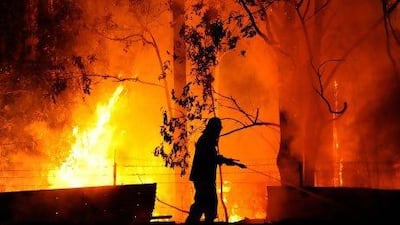SYDNEY // It was a day of temperatures so extreme that Outback roads melted and meteorologists had to add new colours to their forecast charts.
It was also one of the most dangerous fire days on record and, when dusk fell last night without a single life being lost in hundreds of blazes raging across southern Australia, it seemed nothing short of a miracle.
Monday was the hottest day in the country since records began, with an average maximum of 40.3°C, and yesterday looked set to overtake it once calculations were completed this morning. Thousands of firefighters battled flames, with Tasmania - where more than 100 homes were lost at the weekend - and New South Wales worst affected.
Amid "catastrophic" conditions similar to those in Victoria during the 2009 disaster in which 173 people died, dozens of homes remained under threat in New South Wales. More than 130 wildfires were still burning, 30 of them out of control. "It's like someone put the hairdryer on your face," Eva Toth, a motel owner in the township of Tarcutta, said of the heat as she packed up a few belongings and prepared to flee.
In Tasmania, where 100 people remain unaccounted for following a massive fire that ravaged the south-east of the island last Friday, emergency teams searched burnt-out homes but, as of late yesterday, had found no bodies. There was more misery for locals as dozens of fires flared up again, threatening a clutch of small towns on the Tasman Peninsula.
Searing heat, strong winds and low humidity have combined to create lethal fire conditions across southeastern and central Australia, with the risk exacerbated by abundant vegetation on the ground following two years of above-average rainfall. "You don't get conditions worse than this," said Shane Fitzsimmons, head of the New South Wales Rural Fire Service.
Many Australians woke up yesterday to temperatures already above 30°C. In the town of Bega, in southern New South Wales, it was 37.8° C at 9am, the mercury having risen nearly 15 degrees in the previous hour. In Sydney, where thousands of homes suffered power cuts thanks to soaring demand for air-conditioning on one of the city's hottest days, it was still 35°C at 11pm.
In Tasmania, where the only route in and out of the Tasman Peninsula was opened to allow thousands of locals and tourists marooned there by wildfires since Friday to leave in convoy, striking stories of survival emerged. In the seaside town of Boomer Bay, where 15 homes were wrecked, Merle and Terry Klug were thankful to be alive.
"We were lucky enough to see it coming and went down to the boat ramp with 200-odd people … and watched it just come in all around," Mrs Klug told Australia's ABC radio. "We couldn't go anywhere. The heat was horrendous. It's a wonder everything didn't go up." Mr Klug said the fire came "over the hill like a bullet, cracking in the air", then raced right down to the water's edge, burning several cars near the jetty.
Another Boomer Bay resident, Simon Brooks, who makes pewter sculptures, lost his house and a workshop, along with priceless moulds. Although the town remained under threat yesterday, he and his son, Sully, were staying on to look after their one remaining workshop. "We're digging in," he told Australian Associated Press.
In the cities, people sought refuge yesterday in air-conditioned libraries and cinemas, with the latter recording audiences on a par with Boxing Day, traditionally the busiest day of the year. Thousands headed for the beaches, where extra lifeguards were on duty. At Sydney's busy railway stations, staff handed out bottled water, while misting fans on platforms helped to keep commuters cool.
At Sydney's Taronga Zoo, keepers hosed down the animals and fed them frozen carrots and meat ice blocks.
In Melbourne, where flames licked at the back fences of outer suburban homes yesterday, a dozen children were rescued from cars in which they had been locked by their parents, with the windows closed. Some required hospital treatment. "It's like putting a gun to your child's head," commented Paul Holman, the operations manager of Ambulance Victoria.
The hottest place in Australia was Warburton, in the Northern Territory, which recorded 47.2°C. It was nearly matched by another Outback town, Oodnadatta, in South Australia, which has had a week of 45°C-plus temperatures. "The bitumen road's melting, but you don't really blame it," said one local, Lynnie Plate.
As records tumbled, the Bureau of Meteorology added deep purple and pink to its forecasting charts, to extend a temperature range that previously went no higher than 50°C. Ominously, the charts are already showing patches of purple - denoting above-50°C heat - for South Australia early next week.
Yesterday and early today, though, there was some relief as a cool change slowly travelled through southern areas. Temperatures were due to drop to the mid to high 20s, with a 16°C maximum forecast for the Tasmanian capital, Hobart. The respite will be brief. The scorching weather - and perilous fire conditions - will return later in the week.

